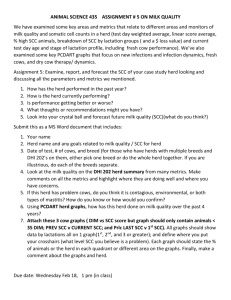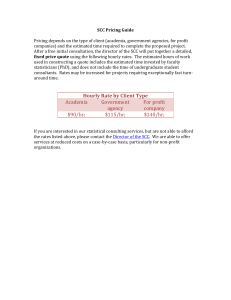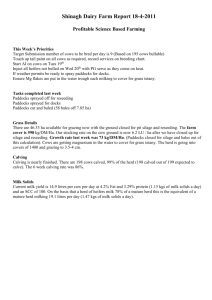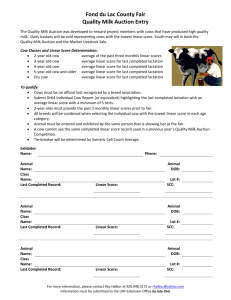DHIA INDIVIDUAL COW, HERD SUMMARY, AND QUILTING WORKSHOP Leo Timms
advertisement
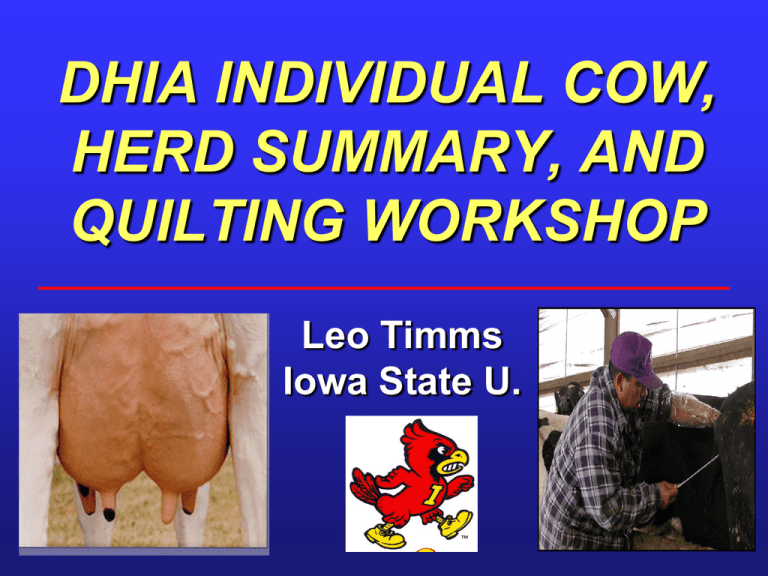
DHIA INDIVIDUAL COW, HERD SUMMARY, AND QUILTING WORKSHOP Leo Timms Iowa State U. HOWDY, I’M LEO I’m a dairy guy! RECORDS Data is: **Accurate!!! **Timely **Precise measurements ** Human data entry (raw/ calculated) Snapshots / photographs • Who is (not) in the picture? • What time frame? Today? Yesterday? • Does picture represent what I’m looking for? Interpretation depends on yesterday!! MONITORING IS A MUST!!!! Records Evaluation • When evaluating records, always consider how the data may be influenced by statistical errors: – Averages – (small numbers, wide range) – Bias – Momentum – Lag – Variation 5 Data Evaluation • Momentum – Influence that previous measurements have on a parameter. • Lag – The time it takes for a parameter to show a change in response to a problem or management change – Ex. 6 – Rolling Herd Av -Calving Interval Data Evaluation • Variation – For all calculations there is an underlying distribution of individual performance. • It is possible that the status of problem animals can be hidden behind an acceptable average. • Sometimes it is important to look at the individual data that lies behind a summary parameter. 7 BENCHMARKING What is a benchmark??? REFERENCE POINT!!! • Where I’m at! • Where I want to go! • Where others are at! • Maximum / minimum! Optimum! • Realistic!!!!!!!!!! BENCHMARKING SCC/ REPRO / HEALTH HERD OR INDIVIDUAL COW? Lowest SCC vs Highest Preg Rate vs maximal healthy udders Get all cows pregnant in timely manner REPRODUCTION INCOME EXPENSES Feed Labor Supplies replacements Milk culls calves Labor Feed Milk and nutrition production Quantity! Quality! Price! DHIA RECORDS: What do I do with them? OR GOLD? GARBAGE? Leo Timms, Iowa State Univ., ltimms@iastate.edu Individual cows ???? DHI – 202!!!!!!! TWO MINUTE DRILL!!! MONITORING MILK PRODUCTION • Bulk tank milk!! (slips at farm!!!) • Meters ( individual cows) • DAIRY RECORDS!!!!!!! BUT WHAT DO YOU LOOK FOR? HOW DO YOU INTERPRET? Daily milk / cow /day 80 75 70 65 /6 10 /1 10 3 0 /2 0 1 /2 10 7 /3 11 /1 11 0 /1 11 7 4 /2 1 1 /1 12 /8 12 /1 12 5 /2 12 date Series1 2 /2 12 9 5 1/ 12 1/ 19 1/ 26 1/ 2 2/ 9 2/ 16 2/ Younger cows produce < old cows Monitor separately!!! How much milk on test day? 88- 92% Pays the bills! Historical! Now vs 1 yr ago Many influences! 150d / MLM milk Standardize cow/herd Apples to apples! Month / month compare! Short term changes! Baggage! Mask Repro! Pays the bills! Historical! Now vs 1 yr ago Many influences! “EARLY LACTATION” Highest Milk Avg. of 2 highest of 1st 3 tests Heifer Repro 75-80% of older cows How high are cows peaking? • Peak Milk = Highest milk production of the lactation. – When does it occur – 35 DIM, 65 DIM, 220 DIM (BST)? – Does it include all the peaks from the current lactations or only the cows that peaked this test? • What is the value of peak for current fresh cow performance? • Summit Milk – Average of the highest 2 of the first 3 tests. • 1# of peak or summit is worth ~225#’s of milk throughout the lactation. 24 When are cows peaking? 8-10 # Watch the numbers! 10-12 # 12-15 # FRESH COWS When are cows peaking / HOW MUCH? How well are fresh cows doing compared to past? HERD EVALUATION LOTS OF MILK U MAKE THE CALL! KEY QUESTIONS ? 1. How is my herd performing currently? 2. How has my herd performed in the past? 3. Is performance getting better or worse? 4. What things / changes should I be thinking about? Bacteria counts, SCC, bulk tank cultures (useful but after the fact!) MILK QUALITY (SCC) Excellent Herd <150,000 Cow <150,000 > 200 – 283,000 Problem ? Illegal > 750,000 SCC BENCHMARKS • SCC < 150-200,000 (ultimately) • New infections (high SCC) < 5% • Clinical mastitis / mo. < 2% • % 1st lact. < 200,000 (LS 4) > 90% • % older cows < 200,000 > 80% • % early lact. > 200,000 < 10% • % culled for mastitis: < 8%? WHAT IS A PROBLEM HIGH COW SCC? • INDIVIDUAL COW BASIS: • > 200 – 283,000 SCC!!! • Linear Score (LS) > 4 – 4.5 WHAT IS A PROBLEM GOAT HIGH SCC? • Early / mid lactation: > 300-400,000 • Late lactation: * > 1 million * compare between halves SO YOU WANNA BE AVERAGE? Leo Timms Iowa State University 300,000 SCC 100,000 SCC 1 MILLION! 150,000 SCC 150,000 SCC 150,000 SCC + 8 cases of clinical mastitis 500,000 SCC Contagious or environmental? Or both? 49 cows < 200,000 1 cow > 20 million w/ 100 # milk 50 cows at 500,000! 150,000 SCC(6 mo. later) 50 cows @ 150,000 SCC 40 new heifers, 10 aged cows Cows treated/dumped 1.6 mil. SCC HERD SCC AVERAGE • Made up of individual cow SCC’s • Need surveillance on individual cows • Need to define what a problem cow is! *** SCC > 200 - 283,000? • How many problem cows? • New or old? • 32 heifers (80%) @ 50,000 SCC • 8 heifers (20%) @ 550,000 SCC • 10 aged cows > treated & dumped (1.6 million SCC) Test day 1 Herd 1 SCC 500,000 % > 300,000 2% % new infec. 2% (1) Herd 2 500,000 100% 0% Test day 2 SCC 150,000 % > 300,000 0% % new infec. 0% 150,000 36% 20%(8) HERD SCC 100 700 100 900 Average over all cows # WBC / ml milk By lactation Don’t forget By stage of lactation Whole herd over time Weighted Average SCC (bulk tank?) Sum (each cow SCC X milk) / total milk Avg. SCC score = herd linear score (LS) • no production weights • ~ herd SCC median / milk loss $$$ LS = log of cow SCC Range = 0 – 9+ 1 LS = SCC doubles 1 = 25 2 = 50 3 = 100 4 = 200 5 = 400 6 = 800 7/8/9 = disaster!? HOW MANY PROBLEM COWS? Are they new or old? Who are they? SCC by lactation goals > 90 > 80 > 80 SCC by stage of lactation What is your goal for fresh cows? < 10% HERD EVALUATION CLEAN UDDERS TO START! INSIDE & OUT!!! SCC U MAKE THE CALL! KEY QUESTIONS ? 1. How is my herd performing currently? 2. How has my herd performed in the past? 3. Is performance getting better or worse? 4. What things / changes should I be thinking about? UDDER HEALTH BEYOND PAPER Current Linear SCC vs. Prev. Linear SCC New Cases 6% Chronic 14% Cures 6% MONITORING FRESH COWS 7/ 2006 12% 7 / 2006 9 / 2006 < 2% 9 / 2006 Fresh cow issues 1 / 2007 <3% 1 / 2007 1 / 2007 <3% 30% WINTER TEAT CRACKING CMT testing + cowside + easy + inexpensive - interpretation? Gel Or NO gel? INTERPRETATIONS • Calving day •Day 3 post calving No gel – 100% accurate No gel – 100% accurate Gel: Is/was a problem! Gel: Is/was a problem! 70% infections picked up! 80% infections picked up! However: However: Only 20% gelling infected Only 40% gelling infected Only 20% treatable Only 10% treatable COLOSTRUM + CMT RGT. = POOR MIXTURE !!! GET YOUR FINGERS DIRTY!! •THE MOST ACCURATE TEST IS NO GEL! • When you see gelling, prevent before treating! • If used for treatment, must be based on organism! < 10% CMT+ Fresh Animals (< 5% quarters) HAPPY IOWA COWS REPRODUCTION Calving interval Days open VWP / DFB Heat detection % Conception rate Services / conception Pregnancy rate FRESH COWS REPRODUCTION Gettin’ ‘em pregnant in a timely manner! Economic Goal of Reproductive Programs Getting animals pregnant at a rate that captures maximum net economic benefits. Pregnancy Rate measures the SPEED at which animals become pregnant in a given program. REPRODUCTION EQUATION Calving = Fertile X DFB X Heat X Conc. Interval Animal (VWP) Det.(HD) Rate (CR) Pregnancy rate Essential critical control points! Equation can be balanced many ways! REPRO BENCHMARKS • Calving interval: 12.5 – 14 mo.+ • Days to 1st service: < 70 d+ • Heat detection rate: 70% (>50%)+ • Conception rate: > 40%+ • Services / conception: 1.5 H/ 2 C+ + can be manipulated/ balanced in herd **** PREGNANCY RATE: >20% **** Reproductive culling: < 10% Pregnancy Rate (Risk) • Percentage of animals that become pregnant within a defined period • Influenced by Heat Detection Rate AND Conception Rate Pregnancy Rate (Risk) • US Dairy average PR -12-14% • Many farms above 20% • Increasing Heat Detection Rate is the easiest way to improve Preg. Rate – Submit more cows for service Survival Curve by Pregnancy Rate 10% 12.5% 15% 17.5% 20% 22.5% 25% 27.5% 30% 32.5% 35% 100.0% 90.0% % Open at Cycle End 80.0% 70.0% 60.0% 50.0% 40.0% 30.0% 20.0% 10.0% 0.0% VWP 1st 2nd 3rd 4th 5th 6th 7th 8th 9th 10th Cycle Mark Kinsel – 2001 Pregnancy Rate (Risk) Calculation • What we need to know: – Number of eligible cows – Time frame (typically 21 days) – Voluntary Waiting Period – Known outcome – Number in group (pregnant/ at risk) at the end of the period. Pregnancy Rate (Risk) Calculation • 1 cow C1|C2|C3|Preg Preg Rate= 1 pregnancy/4 cycles =25% C1|C2|C3|Preg 0%|0%|0%|100% Pregnancy Rate (Risk) Calculation C1|C2|C3|C4|C5|C6|C7|Preg 1 preg/8 cycles = 12.5% • 2 cows C1|C2|C3|C4 C1|C2|C3|Preg C1|C2|C3|C4|C5|C6|C7|Preg C1|C2|C3|Preg What is the preg risk? 2 pregnancies/12 cycles = 16.7% REPRO GOLDEN RULES • There are always problem breeders! But how many? 5-10% • GOAL: Max preg rates in normal cows ** minimize normal cows problems / culls • CAN’T CHANGE THE PAST!!! • Rate am I getting cows pregnant TODAY! DHIA Reproduction: The good, bad, and invisible! REPRO INFORMATION • Accurate / complete data entry! • Some measures have momentum (archaeic)!! CI, DFB • Some measures lag behind! (conception rate due to preg diag.) PAST REPRO HISTORY 85-90% bred w/in 21 days of VWP Compare to VWP ? Distribution more important! When are cows bred first time! PREGNANCY RATE L A g Average vs. Change over time TODAY’S BREEDING HERD Problem cows? What should this be? HD, PR calculations based on this!! Don’t forget ! HERD EVALUATION REPRODUCTION U MAKE THE CALL! REPRODUCTION BEYOND PAPER DAYS IN MILK AT FIRST SERVICE 95 – 100% within 21 days of VWP PREGNANCY RATE > 20% Heat detection > 60% Conception rate > 35% CULLING !!!! CULLING !!!! WHAT %? 25-30? 35! % culled < 30 DIM: 4% % culled < 60 DIM: 6% !!!!! ? ! 8 8 <5 < 15- 20% WHAT AGE? WHAT REASON? QUILTING CLASS Integrated health / herd management Tieing the pieces together! Lots of little pieces! Each has a purpose! Each takes time! Can be tedious / frustrating! Takes concentration! Never gets done if not worked on! WHOLE (sum) IS GREATER THAN PARTS MILK PRODUCTION UDDER HEALTH CULLING REPRO OTHER DHIA PUTTING IT ALL TOGETHER HERD EVALUATION Putting the pieces TOGETHER! U MAKE THE CALL! TWO MINUTE DRILL!!! HOMEWORK KEY QUESTIONS ? MILK PRODUCTION / SCC/REPRO/CULLING 1. How is my herd performing currently? 2. How has my herd performed in the past? 3. Is performance getting better or worse? 4. What things / changes should I be thinking about? WHAT CAN FAT AND PROTEIN REALLY TELL US? Leo Timms Iowa State University Breed Average Fat, Protein & Ratio Breed Total Fat Total Protein Fat:Protein Ratio Ayrshire 3.86 3.18 1.21 Brown Swiss 4.04 3.38 1.20 Guernsey 4.51 3.37 1.34 Holstein 3.65 3.06 1.19 Jersey 4.60 3.59 1.28 Heinrichs, J., et al., Milk components: understanding the causes and importance of milk fat and protein variation in your dairy herd, Penn State University, DAS 05-97 142 143 Fat % High P r o t e i n % H N L Normal Low Fat % High P r o t e i n % Low H production Normal Wishful thought Low Acidosis? Fat:Pro Inv? Grain fiber Testing am/pm Low N production NORMAL? Fat:fiber/TFA High grain/RUP High Fat Ketosis? Low RDP Fat/ lowRDP L MILK UREA NITROGEN (MUN) MILK UREA NITROGEN • Normal values: 10-14 mg/dl • Lower value with high corn silage diets • Breed differences: Jersey ? • Seasonal differences: Summer? • Look at milk protein values also! MILK COMPONENTS: INDIVIDUAL COW DATA Low fat / protein! Acidosis! Fresh cow ketosis < 30% 1.5 F:P MUN: 9-12 Protein to Fat Ratios 2.5 Protein to Fat Ratio 2.0 1.5 1.0 0.5 0.0 0 50 100 150 200 Days in Milk 250 300 350 FOR ANY FURTHER INFO: (videos, papers, jokes, etc.) Leo Timms I’m all 515-294-4522 milked out! 515-294-2393 (fax) ltimms@iastate.edu Thanks! That’s all folks!


